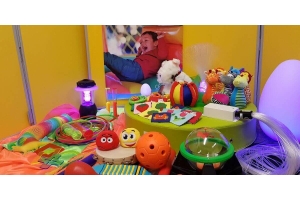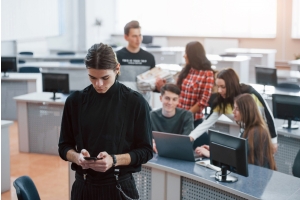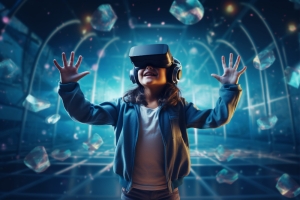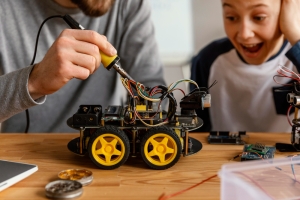How to Integrate Technology in the Classroom
How to Integrate Technology in the Classroom
In today's fast-paced digital world, technology has become an indispensable part of our daily lives, and education is no exception. As educators strive to create engaging and effective learning environments, integrating technology into the classroom has emerged as a key strategy. Merconnet Electronics is at the forefront of this educational revolution, providing innovative solutions to help educators harness the power of technology in teaching and learning.
How to Incorporate Technology in the Classroom:
Incorporating technology in the classroom involves more than just introducing devices; it requires thoughtful planning, implementation, and ongoing support. One effective approach is to start by assessing the specific needs and goals of your students and curriculum. Identify areas where technology can enhance learning experiences and support educational objectives.
Once you've identified potential areas for integration, explore the wide range of educational technologies available. From interactive whiteboards and tablets to educational software and online resources, there are countless tools that can enrich classroom instruction and engage students in new and exciting ways.
Interactive Displays and Smart Boards:
Replace traditional whiteboards with interactive displays and smart boards. These advanced tools enable teachers to deliver dynamic lessons, annotate content, and engage students in interactive activities. With features like touch-screen capabilities and multimedia integration, learning becomes more immersive and collaborative.
Digital Learning Platforms:
Embrace digital learning platforms that offer a wealth of educational resources, such as videos, simulations, and interactive exercises. Platforms like Khan Academy, Coursera, and Moodle provide access to a vast library of content tailored to different learning styles and levels. By supplementing traditional teaching methods with digital resources, educators can cater to diverse student needs and enhance comprehension.
1:1 Devices:
Implement a 1:1 device program where each student has access to a laptop or tablet. This initiative promotes personalized learning experiences, empowers students to explore topics at their own pace, and fosters digital literacy skills. Additionally, teachers can leverage educational apps and software to deliver customized lessons and track student progress effectively.
How to Utilize Technology in the Classroom:
Utilizing technology effectively in the classroom requires more than just access to devices; it requires training and support for educators to effectively integrate technology into their teaching practices. Professional development opportunities, workshops, and ongoing coaching can help teachers build the skills and confidence they need to effectively utilize technology in their classrooms.
Additionally, it's important to ensure that technology is accessible to all students, regardless of their backgrounds or abilities. Providing equitable access to devices and resources, as well as considering issues of digital literacy and internet safety, are essential aspects of utilizing technology in the classroom.
Flipped Classroom Model:
Implement the flipped classroom model, where students consume instructional content at home through videos or online modules and engage in hands-on activities, discussions, and problem-solving in class. This approach maximizes classroom time for active learning and facilitates deeper understanding through application-based tasks.
Data-Driven Instruction:
Leverage data analytics tools to gather insights into student performance and tailor instruction accordingly. By analyzing assessment data, teachers can identify areas of strength and weakness, differentiate instruction, and provide targeted interventions to support student growth. Additionally, data-driven instruction promotes accountability and enables educators to measure the effectiveness of teaching strategies.
How Can We Use Technology in the Classroom:
As we look to the future of education, the possibilities for using technology in the classroom are limitless. Virtual reality simulations, artificial intelligence tutors, and personalized learning platforms are just a few examples of the innovative technologies that hold the potential to transform education in the years to come.
By embracing new technologies and continuously seeking out innovative solutions, educators can create dynamic learning environments that inspire curiosity, creativity, and critical thinking in their students.
Gamification:
Integrate gamification elements into lessons to make learning more engaging and motivating. Gamified activities, such as quizzes, simulations, and educational games, tap into students' intrinsic motivation, foster healthy competition, and incentivize progress. By transforming learning into a fun and interactive experience, educators can increase student participation and retention.
Online Assessments and Feedback:
Embrace online assessment tools to streamline the evaluation process and provide timely feedback to students. Platforms like Kahoot!, Quizizz, and Google Forms offer customizable assessment options, instant grading, and actionable feedback mechanisms. By leveraging technology for assessments, educators can efficiently measure learning outcomes, identify areas for improvement, and track student growth over time.
How Do We Use Technology in the Classroom:
At Merconnet Electronics, we believe in the power of technology to revolutionize education and empower both educators and students. That's why we offer a wide range of educational technology products and solutions designed to enhance teaching and learning in the classroom.
From interactive whiteboards and document cameras to robotics kits and STEM learning resources, our products are carefully selected to support hands-on, inquiry-based learning experiences that promote collaboration, problem-solving, and creativity.
Collaborative Tools:
Utilize collaborative tools such as Google Workspace (formerly G Suite) or Microsoft Teams to facilitate communication and collaboration among students. These platforms enable real-time document sharing, virtual group discussions, and project collaboration, regardless of physical location. By fostering teamwork and communication skills, students are better prepared for the demands of the modern workplace.
Virtual Reality (VR) and Augmented Reality (AR):
Harness the power of VR and AR technologies to create immersive learning experiences. Whether exploring historical landmarks, dissecting virtual organisms, or simulating scientific experiments, these immersive technologies transport students beyond the confines of the classroom, making learning more engaging and memorable.
Conclusion:
In conclusion, integrating technology into the classroom holds immense potential to transform education and prepare students for success in the digital age. By embracing innovative tools, pedagogical approaches, and collaborative partnerships, educators can create dynamic learning environments that inspire curiosity, creativity, and lifelong learning. At Merconnet Electronics, we remain committed to empowering educators with the resources and support needed to harness the power of technology and unlock the full potential of every student. Together, let's embark on a journey of educational innovation and empowerment.
 Live Chat
Live Chat







